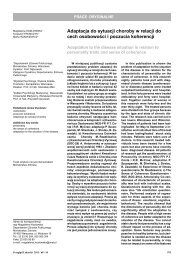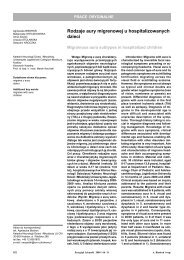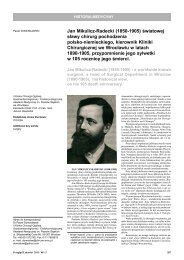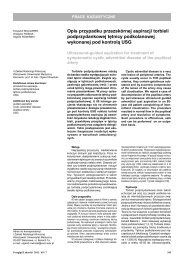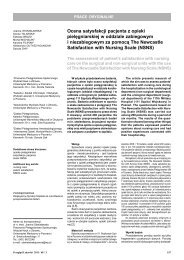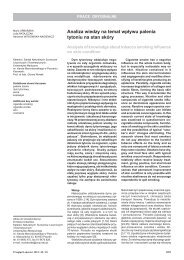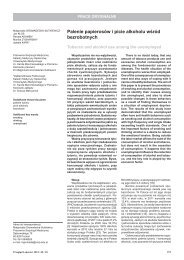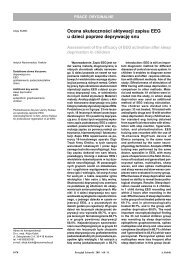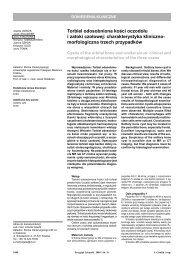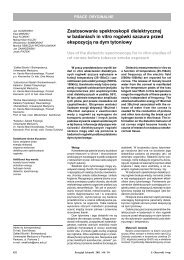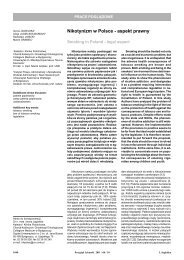Wzorzec-przegl d lekarski-XX-2001
Wzorzec-przegl d lekarski-XX-2001
Wzorzec-przegl d lekarski-XX-2001
Create successful ePaper yourself
Turn your PDF publications into a flip-book with our unique Google optimized e-Paper software.
Introduction<br />
Social scientists have paid relatively little<br />
attention to quality of sleep, nor have they<br />
assessed whether social factors mediate<br />
gender differences in sleep quality. This<br />
paper examines the British Psychiatric Morbidity<br />
Survey [28] to better understand gender<br />
and marital status differences in sleep<br />
problems.<br />
It is well-known in sleep research that<br />
women report higher levels of sleep complaints<br />
than men [16, 26, 33]. A meta-analysis<br />
of 29 published studies concluded that<br />
the overall risk ratio of insomnia was 1.41<br />
for women compared to men [33]. Biological<br />
or physiological sex differences are often<br />
identified as explanations for women's<br />
higher levels of disturbed sleep [4,7,19], and<br />
psychological explanations are also prevalent<br />
[19]. Women have higher levels of depression<br />
and anxiety, and research shows<br />
that individuals suffering from psychiatric<br />
disorders, such as depression and anxiety,<br />
have poorer quality sleep [23,30]. However,<br />
gender differences in sleep quality remain<br />
after removing the effects of women's higher<br />
rates of psychiatric morbidity [19,33].<br />
Studies of gender differences in sleep<br />
less frequently consider sociological explanations.<br />
Chen et al.[4] conclude that 'In contrast<br />
with explanations emphasising gender<br />
differences in biology and prior psychiatric<br />
illnesses, the sociological perspective has<br />
not been well investigated in the existing<br />
literature.' They found that the gender difference<br />
in sleep disturbance was reduced<br />
after controlling for women's social roles<br />
(using marital status, employment status,<br />
and number of children under 15 as a proxy<br />
for childcare responsibilities). However,<br />
women's sleep quality still remained significantly<br />
poorer than men's, suggesting the<br />
need for research on gender differences<br />
using more extensive measures of social<br />
roles and socio-economic status (SES).<br />
Sekine et al. [26] found that the gender difference<br />
in reported sleep quality among<br />
Japanese civil servants could be entirely<br />
explained by gender differences in work<br />
characteristics, domestic roles and familywork<br />
conflicts. However, it remains unclear<br />
whether gender differences can be explained<br />
by socio-economic, work and family<br />
characteristics among nationally representative<br />
population samples.<br />
Other researchers have shown the<br />
poorer sleep quality of the divorced/separated<br />
and of widowed people. However, it<br />
is also important to examine whether there<br />
is a gender and marital status interaction in<br />
relation to sleep quality, rather than simply<br />
analysing gender and marital status as additive<br />
variables within analyses. In particular,<br />
whether there are greater marital status<br />
differences among men than women,<br />
and the reasons underlying any such differences.<br />
Married men have been shown<br />
to be particularly advantaged, regarding a<br />
number of other dimensions of well-being<br />
(including income, material circumstances,<br />
health and social support), with smaller<br />
marital status differences found among<br />
women than among men [1]<br />
A major reason for poorer sleep quality<br />
is because chronic ill-health causes pain and<br />
discomfort at night, resulting in sleep complaints<br />
and disorders [5, 29, 32]. Since poor<br />
physical and mental health is associated<br />
with disrupted sleep it is important to assess<br />
whether gender or marital status differences<br />
in sleep quality are confounded by poorer<br />
health among women and among those who<br />
are previously married.<br />
Materials and Methods<br />
This paper addresses the following research questions:<br />
(1) What is the relative contribution of socio-economic<br />
characteristics, compared with smoking, worries,<br />
poor health and depression, in explaining gender differences<br />
in sleep problems<br />
(2) How does the association between marital status<br />
and sleep problems differ among women and men,<br />
and what is the relative contribution of socio-economic<br />
characteristics and other factors to marital status differences<br />
in sleep problems<br />
The paper analyses a British nationally representative<br />
cross-sectional survey: the 2000 Psychiatric Morbidity<br />
Survey [28]. Home interviews (averaging 1 1/2 hours)<br />
were conducted with 8,580 people aged 16-74. A representative<br />
sample of addresses was selected from the<br />
Postcode Address File with one household member aged<br />
16-74 randomly selected for interview from each sample<br />
household. The response rate of 69.5% is high, considering<br />
the length and complexity of the interview [28, 29].<br />
The maximum age is 74 years, therefore our findings<br />
cannot be generalised to older people above this age.<br />
Sleep Problems<br />
Sleep problems were measured as part of the revised<br />
version of the Clinical Interview Schedule (CIS-R)<br />
[18]. Respondents were asked: 'In the past month, have<br />
you been having problems with trying to get to sleep or<br />
with getting back to sleep if you woke up or were woken<br />
up' Those answering 'Yes', were asked: 'On how many<br />
of the past seven nights did you have problems with your<br />
sleep' Three response categories were provided: None;<br />
1 to 3 nights; 4 nights or more. The paper analyses a<br />
dichotomous variable of reporting sleep problems on 4<br />
or more nights per week (versus less often) as an indicator<br />
of frequently experienced sleep difficulties.<br />
Socio-demographic and socio-economic<br />
characteristics<br />
Age was categorised as 16-24, 25-34, 35-44, 45-<br />
54, 55-64, 65-74.<br />
Marital status - Married/cohabiting, Never married,<br />
Widowed, Divorced/separated. Number of children living<br />
in the household, coded as None, 1, 2, 3 or more.<br />
Highest educational qualifications were coded into<br />
4 ordinal categories: Degree level or higher qualifications;<br />
Professional, teaching, or technical qualifications<br />
and A levels (national examinations taken at 18 and required<br />
for university entry); Lower qualifications, e.g.<br />
GCSE/O levels, secretarial, trade and apprenticeship<br />
qualifications; and No educational qualifications.<br />
Employment status was self-reported as Full-time<br />
employed, Part-time employed, Unemployed (looking for<br />
work in last 4 weeks) or Economically inactive (coded<br />
from main reason not working in last 4 weeks as retirement,<br />
full-time student, household duties, or disability/<br />
long-term sick).<br />
Housing tenure was coded as Owns accommodation;<br />
Rents from Public Housing (Local Authority or Housing<br />
Association); or Rents from other sources, primarily<br />
private renting.<br />
Household income is measured by the sum of personal<br />
gross income from all sources for each household<br />
member, equivalised using the McClements Scale [6],<br />
which adjusts for differences in number of adults and<br />
children in the household. Income was coded into 5 ranges:<br />
the lowest category (< £ 150 per week) comprises<br />
20% of the whole sample, and the highest (> £ 750 per<br />
week) comprises 12%.<br />
Measures of other variables<br />
Smoking was categorised as Never smoked, Exsmoker<br />
and Current smoker.<br />
Worries. Self-reported data about Worries (in general),<br />
Worries about health, and Depression were obtained<br />
using the CIS-R symptom scores [18]. For each<br />
of these measures, interviewees were asked if they had<br />
experienced 4 different symptoms in the last 7 days. In<br />
each case, this was scored as None, Medium (1 symptom<br />
reported), and High (2 or more symptoms reported).<br />
Self-rated (or self-assessed) health is used extensively<br />
in research on determinants of health, and is a<br />
good predictor of mortality and general health [8,14]. Selfrated<br />
health was measured by asking: 'How is your health<br />
in general Would you say your health is Excellent, Very<br />
Good, Good, Fair or Poor', recoded into 3 categories:<br />
Very good (representing 'excellent' or 'very good'), Good,<br />
and Poor (representing 'fair' or 'poor').<br />
Number of chronic illnesses was measured by asking;<br />
'Do you have any long-standing illnesses, disability<br />
or infirmity By long-standing I mean anything that has<br />
troubled you over a period of time or that is likely to affect<br />
you over a period of time.' Respondents self-reporting<br />
'Yes', were asked 'What is the matter with you' and<br />
each health problem mentioned was recorded. The total<br />
number of long-standing health problems self-reported<br />
were summed, and recoded as None, 1, 2, 3 or more.<br />
Statistical analysis<br />
The proportions of men and women reporting sleep<br />
problems on 4 or more nights a week are analysed for<br />
each of the above variables, with chi-squared probability<br />
values reported (Tables 1-2). Hierarchical logistic regression<br />
models are presented to examine the two research<br />
questions addressed in the paper.<br />
Statistical analyses were performed using SPSS<br />
(version 13, SPSS, Inc., Chicago, IL). Statistical tests<br />
used .05 (2 tailed) significance levels. To allow the<br />
strength and precision of the relationships to be assessed,<br />
results are presented as odds ratios (OR) with<br />
their associated 95% confidence intervals (CI).<br />
Results<br />
Gender differences in sleep problems<br />
- bivariate analyses<br />
Tables I and II show the proportion of<br />
men and women reporting sleep problems<br />
on 4 or more nights per week in relation to<br />
socio-demographic, socio-economic, health<br />
and other variables. More women (20%)<br />
than men (14%) report sleep problems on 4<br />
or more nights per week. A significant relationship<br />
with age is found for women but not<br />
for men. The highest proportion of women<br />
reporting sleep problems are age 45-54<br />
(24%) with a modest decline above this age.<br />
The divorced/separated report the worst<br />
sleep among both women (27%) and men<br />
(26%), followed by the widowed (26%<br />
women, 21% men). The gender difference<br />
in sleep problems is greater among married<br />
people (18% of married women and 12.5%<br />
married men report sleep problems), than<br />
among the single (16% vs 12%), or divorced.<br />
This suggests that the sleep advantage of<br />
marriage may be primarily experienced by<br />
married men, rather than married women,<br />
which would accord with results from a<br />
range of qualitative studies [13,31].<br />
Significant associations with sleep problems<br />
are found for each socio-economic status<br />
(SES) measure, which are broadly comparable<br />
for men and women. Regarding<br />
household income, only 10% in the highest<br />
income group report sleep problems compared<br />
with 25% in the lowest income group.<br />
Adults with more education report fewer<br />
sleep problems; only 12% with a degree report<br />
sleep problems compared with 22%<br />
who have no qualifications. The unemployed<br />
(22%) and economically inactive (25%) are<br />
more likely than the full-time employed<br />
Przegl¹d Lekarski 2012 / 69 / 2<br />
55



